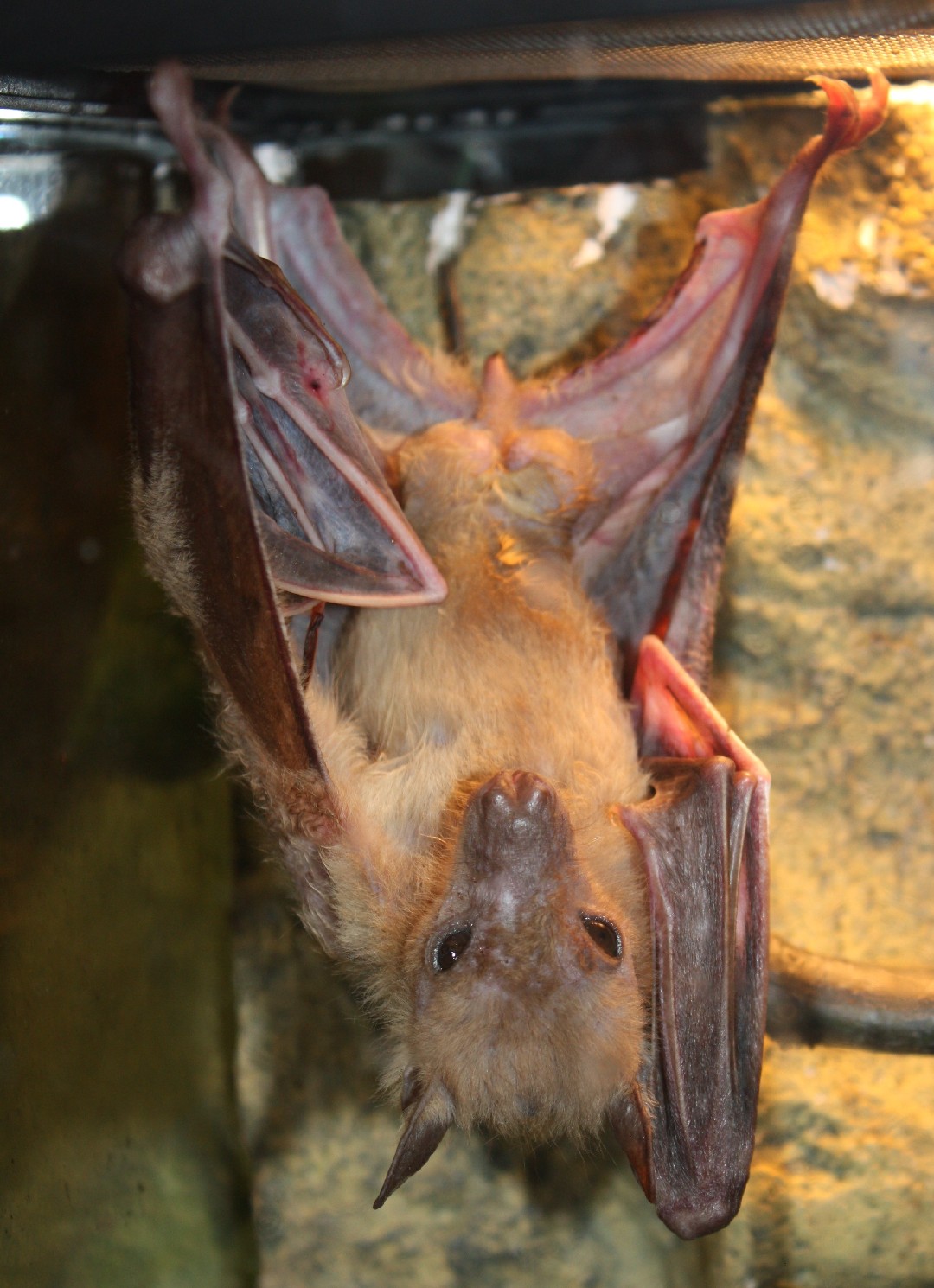Indian flying fox
A species of Fruit bats Scientific name : Pteropus giganteus Genus : Fruit bats
Indian flying fox, A species of Fruit bats
Botanical name: Pteropus giganteus
Genus: Fruit bats
Content
Description People often ask General Info
 Photo By J. Patrick Fischer , used under CC-BY-SA-3.0 /Cropped and compressed from original
Photo By J. Patrick Fischer , used under CC-BY-SA-3.0 /Cropped and compressed from original Description
The Indian flying fox is India's largest bat, and one of the largest bats in the world, weighing up to 1.6 kg (3.5 lb). Its body mass ranges from 0.6–1.6 kg (1.3–3.5 lb), and males are generally larger than females. The wingspan ranges from 1.2–1.5 m (3 ft 11 in–4 ft 11 in) and body length averages 15.5–22.0 cm (6.1–8.7 in). The wings rise from the side of the dorsum and from the back of the second toe, and its thumb has a powerful claw. It has claws on only its first two digits of its wings, with the thumb possessing the more powerful claw, and all five digits of its leg. It lacks a tail. The Indian flying fox ranges in color, with a black back that is lightly streaked with grey, a pale, yellow-brown mantle, a brown head, and dark, brownish underparts. It has large eyes, simple ears, and no facial ornamentation—a typical appearance for a species of the genus Pteropus. The skull is oval-shaped and the greatest length of the skull is 71–75.6 mm (2.80–2.98 in). The orbital rim of the skull is incomplete. The ears lack a tragus or antitragus and are ringed, and the ears range in length from 35–40 mm (1.4–1.6 in) in length. The dental formula is 3.1.4.22.1.4.3. The first upper premolar is absent, the canine is pronounced, and the molars have a longitudinal furrow. As of 1999, it is the longest-lived member of its genus; one individual lived for 31 years and 5 months in captivity. 
Size
16 - 22 cm
Colors
Brown
Black
Yellow
Bronze
Gray
Life Expectancy
31.4 years
Nest Placement
Tree
Feeding Habits
Indian flying fox is frugivorous, consuming a variety of fruits, nectar, and occasionally insects and leaves. Its feeding behavior involves foraging at dusk. Indian flying fox has a unique role in seed dispersion and propagation, especially of the banyan tree, and displays seasonal dietary changes.
Habitat
The Indian flying fox is found across the Indian Subcontinent, including in Bangladesh, Bhutan, India, Tibet, Maldives, Myanmar, Nepal, Pakistan and Sri Lanka. It roosts in large, established colonies on open tree branches, especially in urban areas or in temples. It prefers to roost on tall trees with small diameters, especially canopy trees, and prefers to be in close proximity to bodies of water, human residences, and agricultural land. This habitat selection is highly dependent on food availability. For example, many residences within the bat's distribution have outdoor gardens that support its generalist frugivorous feeding habits. This tendency to support a generalist frugivorous diet through habitat selection also leads it to commonly roost in highly fragmented forests, where the variety of plant species allows it to better utilize its feeding habits. Its populations are constantly threatened through habitat destruction caused by urbanization or widening of roads. Tree roosts are often felled and colonies dispersed. Smaller colonies tend to remain in place longer than larger colonies, as those larger colonies have their roosts felled more quickly. 
Dite type
Frugivorous
People often ask
General Info
Feeding Habits
Bird food type

Fruit
Behavior
The Indian flying fox roosts communally in the treetops of large trees in camps often with thousands of bats. Roosts tend to be used for upwards of ten years, and are usually inhabited year-round rather than seasonally. Within the roost the bats quarrel and chatter often, and during sunny hours of the day bats fan their wings and call, and during cloudy periods bats are silent and wrap their wings around their body. Occasionally a few bats fly around the roost during the day, but most activity is restricted to night, when they leave the roost one by one 20–30 minutes after the sunset. Bats at the top of the roost tend to circle the roost and leave before the rest of the colony emerges. The time of bat emergence was significantly influenced by the day length, sunset and the ambient temperature delayed the time of emergence. The bats fly with the appearance of a large swarm but forage individually, and give off contact calls infrequently. Individuals travel upwards of 93 mi (150 km) in search of food, finding it by sight. It can quickly travel up and down tree branches to forage for fruit with a swift hand-over-hand motion. 
Distribution Area
The Indian flying fox is found across the Indian Subcontinent, including in Bangladesh, Bhutan, India, Tibet, Maldives, Myanmar, Nepal, Pakistan and Sri Lanka. It roosts in large, established colonies on open tree branches, especially in urban areas or in temples. It prefers to roost on tall trees with small diameters, especially canopy trees, and prefers to be in close proximity to bodies of water, human residences, and agricultural land. This habitat selection is highly dependent on food availability. For example, many residences within the bat's distribution have outdoor gardens that support its generalist frugivorous feeding habits. This tendency to support a generalist frugivorous diet through habitat selection also leads it to commonly roost in highly fragmented forests, where the variety of plant species allows it to better utilize its feeding habits. Its populations are constantly threatened through habitat destruction caused by urbanization or widening of roads. Tree roosts are often felled and colonies dispersed. Smaller colonies tend to remain in place longer than larger colonies, as those larger colonies have their roosts felled more quickly. 
Scientific Classification
Phylum
Chordates Class
Mammals Order
Bats Family
Megabats Genus
Fruit bats Species
Indian flying fox